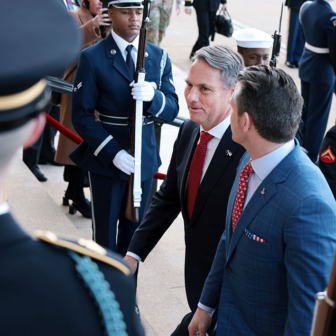Australia’s foreign policy white paper is a study in contrasts. Bright vistas of international opportunity are described beneath storm clouds of “political alienation and economic nationalism.” Here are both dreams and nightmares: a report card on the world — subtitled “Opportunity, security, strength” — that’s also a crystal ball exercise, weaving prediction and prognosis through the policy prescriptions.
Standing in the central atrium of Canberra’s foreign affairs building, prime minister Malcolm Turnbull launched the white paper as the government’s vision of the next decade of “uncertain and dangerous times.” A leader who projects beaming optimism as his personal motif spent a lot of time discussing the paper’s “clear-eyed and hard-headed” approach to an era of rapid change, political uncertainty, strategic ambition and foreign interference.
The United States and China stand at the centre of the paper in the key relationship that will decide much of the next decade. The third paragraph puts it simply: “Today, China is challenging America’s position.”
Shared economic interests may not be enough to produce a sharing of power that suits Beijing or that Washington can accept:
They have a mutual interest in managing strategic tensions, but this by itself is not a guarantee of stability. Compounding divergent strategic interests as China’s power grows, tensions could also flare between them over trade and other economic issues.
Last year’s defence white paper was loud and staunch in its confidence in the US alliance and its belief that America is in Asia to stay. Coming to the end of the first year of the Trump presidency, the foreign policy white paper is needier and more fretful. The subtext of the declarations of deep Oz affection for the United States is the stark question Canberra now faces: what happens if America goes AWOL, heading east of Guam (or even Hawaii) just as Britain once departed east of Suez?
The white paper’s answer is a pledge to do everything possible to see that the nightmare never happens, with repeated affirmations that the US alliance is good for Australia and good for the region:
The alliance is a choice we make about how best to pursue our security interests. It is central to our shared objective of shaping the regional order. It delivers a capability edge to our armed forces and intelligence agencies, giving Australia added weight and regional influence.
The chapter discussing stability in the Indo-Pacific treats the US and China as a linked topic. This is striking. The United States no longer stands alone in our pantheon, but now shares the central pillar with another.
Throughout the paper, the love for the United States is invariably followed by a paragraph on the deep friendship with China. Malcolm Turnbull might worry, in private, about China as a “frenemy,” but this official statement of the Oz worldview is notable for being most China-friendly.
As policy documents, white papers are always significant for their hierarchies and lists. The country hierarchy starts, as you’d expect, with the United States and proceeds to China, Japan, Indonesia and India. Canberra’s embrace of the Indo-Pacific concept gets another big run.
As promised, the Pacific islands and Timor-Leste get particular attention, with one of the eight chapters devoted to our enduring partnership with Papua New Guinea, stepping up engagement with the islands and supporting Timor. The remember-the-Pacific emphasis means the region gets a place in the five objectives of fundamental importance to Australia’s security and prosperity:
- promote an open, inclusive and prosperous Indo-Pacific region in which the rights of all states are respected
- deliver more opportunities for our businesses globally and stand against protectionism
- ensure Australians remain safe, secure and free in the face of threats such as terrorism
- promote and protect the international rules that support stability and prosperity and enable cooperation to tackle global challenges
- step up support for a more resilient Pacific and Timor-Leste.
On the light and optimistic side of the ledger, the paper devotes a page to “dynamic Asia” and the prediction that Asia’s miracle still has much more to give:
The scale of Asia’s transformation is unprecedented. In a little over three decades the region went from one in which more than a billion people lived in extreme poverty to one with more than a billion in the middle class… Over the next ten years, a billion more Asians will join the middle class creating a consumer market larger in number and spending power than the rest of the world combined. Their choices will reshape global markets. By 2030, the region will produce more than half of the world’s economic output and consume more than half of the world’s food and 40 per cent of its energy. By then, more than 600 million additional people will live in the region’s cities.
Power shifts don’t get any bigger than that. As the white paper comments: “For Australia, the stakes could not be higher.” ●




